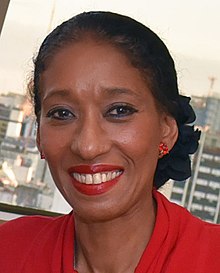Ethnic groups of Argentina
[13] Indigenous peoples continue to have significant populations in the country's north-west (Quechua, Diaguita, Kolla, Aymara); north-east (Guaraní, Mocoví, Toba, Wichí); and in the south or Patagonia (Mapuche, Tehuelche).
More recent migratory flows have come from other Latin American countries, with Paraguayans, Bolivians, Peruvians and Venezuelans making up the bulk of Argentina's modern-day immigrant communities.
[18] Neither official census data nor statistically significant studies exist on the precise amount or percentage of Argentines of European descent today.
At first the number of immigrants was modest compared to other countries such as the United States (though the number of immigrants was steadily increasing as they moved to the rural areas to settle and to found colonias like those of Italian, German, Swiss, or French origin), but in the 1870s, due to the economic crisis in Europe, it started to increase, reaching an extremely high rate between 1890 and 1930.
[23] The Hotel de Inmigrantes, built in 1906 to accommodate the 100,000 to 200,000 yearly arrivals at the Port of Buenos Aires, was made a National Historic Monument.
After the United States and Brazil, Argentina is among the nations with the largest number of German descendants in the world, together with Australia, Canada, South Africa and France.
[28] French immigration has left a significant mark on Argentina, with a notable influence on the arts, culture, science and society of the country.
Approximately 44,000 Swiss emigrated to Argentina until 1940, and settled mainly in the provinces of Córdoba and Santa Fe and, to a lesser extent, in Buenos Aires.
Subsequently, groups of immigrants settled in Buenos Aires, Misiones, Chaco, Corrientes, Formosa, Mendoza, Río Negro, and Entre Ríos.
The overwhelming majority of Argentina's Jewish community derives from immigrants of Northern, Central, and Eastern European origin (Ashkenazi Jews), although there is a significant Sephardic population.
Most Levantine Argentines are from Syrian background, originating mainly from what is now Syria[42] There are people from other Arabic speaking countries in lesser numbers.
In the formative years of the Argentine Republic, a period marked by efforts to foster national unity and identity, assimilation played a significant role in shaping the cultural landscape.
The assimilation process, as observed by Civantos, becomes a nuanced journey wherein the Syro-Lebanese community strategically positions itself within the broader Argentine identity spectrum.
Armenophobia rose again in Turkey in the mid-20th century, and created the final migration of Armenians to the world – some of them arrived in Argentina and formed a separate third wave.
There are Amerindian groups like the Tobas, Aymaras, Guaraníes and Mapuches, among others, who still maintain their cultural roots, but are under continuous pressure for religious and idiomatic integration.
Guarantee respect for their identity and the right to a bilingual and intercultural education; recognise the legal status of their communities, and the communal possession and ownership of the lands they traditionally occupy; and regulate the provision of others suitable and sufficient for human development; none of them shall be alienable, transferable or subject to liens or encumbrances.
Around the 16th century, they began to inhabit a large part of northern Argentina in what are now the provinces of Salta, Chaco, Santiago del Estero and Formosa.
[55] Ava guaraní is the denomination currently adopted for a mixogenized indigenous culture guaraní-arahuaca formerly better known as chiriguana', which is settled mainly in southern Bolivia, from where it expanded into western Paraguay and northwestern Argentina.
[62] The exploration of gold and the introduction of farming in the region of Tierra del Fuego led to genocide of the Selk'nam perpetrated by the regimes of both states (Argentina and Chile).
The Charrúa were an Indigenous Southern Cone people in present-day Argentina (Entre Ríos), Uruguay[64] and Brazil (Rio Grande do Sul).
The Spaniards called the tonocotés and other peoples of the former Tucumán as Juríes, deformation of the Quechua word xuri that means Rhea, because of the kind of loincloth feathers of this bird that the natives wore and that they moved into real flocks.
Also there is a debate, among the historians, as to whether or not Bernardino Rivadavia, the first president of the United Provinces of the Río de la Plata, was of African descent.
One popular myth claims that during the Paraguayan War, thousands of black citizens were forcibly conscripted and used as front-line soldiers, leading to large casualties that decreased the number of Afro-Argentines.
Historian George Reid Andrews retorts that composition of the Argentine Army in 1853 meant that only two battalions of blacks served in the war, and thus this could not have been the cause of the reduction of the Afro-Argentine population.
[86][19] As a result, most of the figures in this table come from varied estimates and sources that attempt to map the different patterns of ancestry that have shaped the modern Argentine population.
The plan attempts to ease the bureaucratic process of getting documentation and residence papers, and is aimed at citizens of Mercosur countries and its associated states (Bolivia, Brazil, Chile, Colombia, Ecuador, Paraguay, Peru, Uruguay and Venezuela).
The plan came after a scandal and a wave of indignation caused by fire in a Buenos Aires sweatshop, which revealed the widespread utilization of undocumented Bolivian immigrants as cheap labor force in inhumane conditions.
As of 2020, Argentina counted with a positive net migration rate (one of the only three such countries in the region, alongside Chile and Costa Rica) and remains a major destination for migrants within Latin America and the Caribbean.
Argentina does not require a visa for Russian citizens to enter the country as tourists and it also allows the parents of children born on Argentinian soil to receive residency, and, later, a passport.
[175][176][177][178][179][180] Argentina is home to the largest foreign-born population in the region (around 2 million migrants), mainly from neighbouring countries such as Paraguay and the Plurinational State of Bolivia.




















